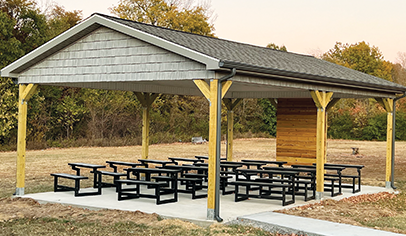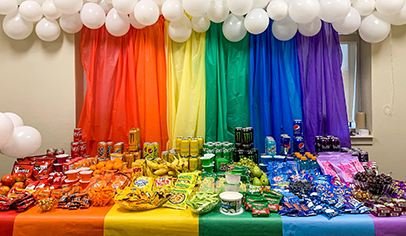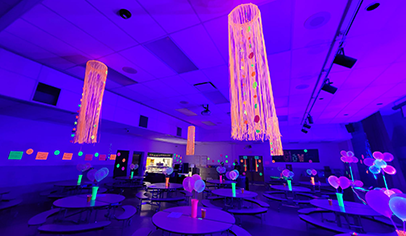Outdoor classrooms are having a moment. While they’ve typically been used at schools in warmer climates, they’re now popping up everywhere, including schools in northern climates and urban areas.
Physical distancing challenges caused by the pandemic and a growing focus on green improvements to schools have prompted many PTOs and PTAs to set fundraising goals specifically to build outdoor learning spaces.
The Natural Benefits
Outdoor classrooms offer more than just a change of scenery. More and more studies show that when students interact with nature, their grades get better; their creative, problem-solving, and intellectual skills grow; and their physical and mental health improve.
For example, in a study for the California Department of Education looking at a group of students with set outdoor learning routines, 27% of students had improved testing scores and they all received higher ratings in social skills, peer relationships, and self-motivation.
Taking learning outside is helpful for teachers, too. They can expand the curriculum with hands-on lessons in reading and writing, scientific observations, and social-emotional activities by connecting lessons with nature.
Design Inspiration
Sunshades, sails, canopies, pavilions, or naturally shaded areas under trees—there are lots of considerations that go into choosing a design for your outdoor classroom. First among them is finding the right space, so work with your school administration to decide the best possible placement.

Photo courtesy of Sumpter Parent-Teacher Club, Salem, Ore.

Photo of early construction phase courtesy of Taylor Clark Glascock, President, Courtland Elementary School, Fredricksburg, Va.
Here are a few design details to think about when choosing a location and the type of structure:
- Are there trees or shade you can use? You’ll want shade of some kind where students can sit comfortably and have a clear view to the whiteboard.
- How much space do you have to work with, and will it fit your needs?
- How many months of the year will the space be used? Ideally your structure would be low-maintenance and able to withstand your region’s weather year-round.
- How many students will be using the area at one time?
- Will you ask for volunteer builders or hire a contractor? Either way, you’ll need to pull building permits from the local government’s building department.
- What type of seating do you want—natural wood or plastic or metal? Just like playground equipment, plastic or metal can get hot under direct sun.
- Do you want flexibility to move benches or workspaces? If so, make sure they’re heavy enough to withstand high winds but still light enough to be moved when necessary.
- Will you build raised beds for garden projects? If so, you might consider a compost area, too.
- Keep the classroom near a school entrance so everyone can move in and out quickly and in an orderly way.
- Will you need electricity in the space?
- The area should be level and accessible by everyone, regardless of physical limitations.
- Find an area that won’t be soggy or muddy during wetter months. If necessary, build up the space to prevent flooding.
Evaluating Costs
Depending on the size and scope of the project, building an outdoor classroom runs anywhere from $500 to as much as $150,000. Local building permits, if needed, fall into that bucket. School districts have lists of approved contractors and suppliers they can share with you.

Photo courtesy of Crystal Moureau, President, Kennedy Elementary Youth Support (KEYS) in Green Bay, Wis.
Set your fundraising goals and be transparent with families about the benefits of using outdoor spaces, how the costs break down, and how much progress you’re making. A well-timed social media campaign can keep everyone updated and build excitement among school staff members and families for the big reveal.

Photo courtesy of Rachel Johnson, Woodland Elementary PTO, Minn.
There are ways to keep costs down. Talk to local building contractors about discounts in exchange for advertising, and connect with garden centers for tree, shrub, mulch, or gravel donations. Put out the call to volunteers who have construction or design backgrounds or experience applying for grants to help out with the process.
Christina Montgomery, former president of the Meador Elementary PTO in Willis, Texas, had seats made from stumps donated by a local tree company. Montgomery’s husband built the chalkboard, and the school’s entire outdoor classroom space cost less than $1,000.


Photos courtesy of Christina Montgomery
Federal and state grants help establish and run outdoor learning programs. For example, California offers grants and funding programs for communities that invest in green infrastructure improvements, like digging up asphalt to create natural landscapes for better stormwater management and drought response. Georgia, New York, Illinois, Iowa, and Maryland all have grant programs that offer trees and plants to help groups create healthy shaded playground and classroom areas, pollinator gardens, and wildlife habitats on elementary school campuses.
Some grants and government funding sources exist to help teachers create programming and curriculum and buy supplies and to help schools provide professional development. And other grant programs help groups design, build, and maintain living schoolyards that produce measurable environmental benefits like heat island mitigation, stormwater management, air quality, and wildlife habitats.
Sometimes grant moneys come from surprising places. The American Academy of Dermatology awards shade structure grants of up to $8,000 to public schools and nonprofit organizations to install permanent shade over areas that aren’t protected from the sun.
A note about grants and federal funding: Virtually all formal grants are available only to organizations officially recognized by the IRS as tax-exempt under section 501(c)(3) of the federal tax code. If your group isn’t yet organized as a 501(c)(3) group, check out our resources at PTOtoday.com/bylaws-nonprofit.
Other Considerations

The Forest Hill Elementary PTA in San Jose, Calif., bought folding picnic tables that convert into benches for its outdoor space. Lightweight and easy to move, the benches give the group flexibility when using the area. The group also built garden boxes where different classes grow plants that the students care for.

Teachers need the convenience of an outdoor storage option like a shed, locker, or waterproof box to hold paper, pens, whiteboard markers, and other supplies. This way, valuable learning time isn’t taken up by multiple trips back into the building for forgotten supplies.

























